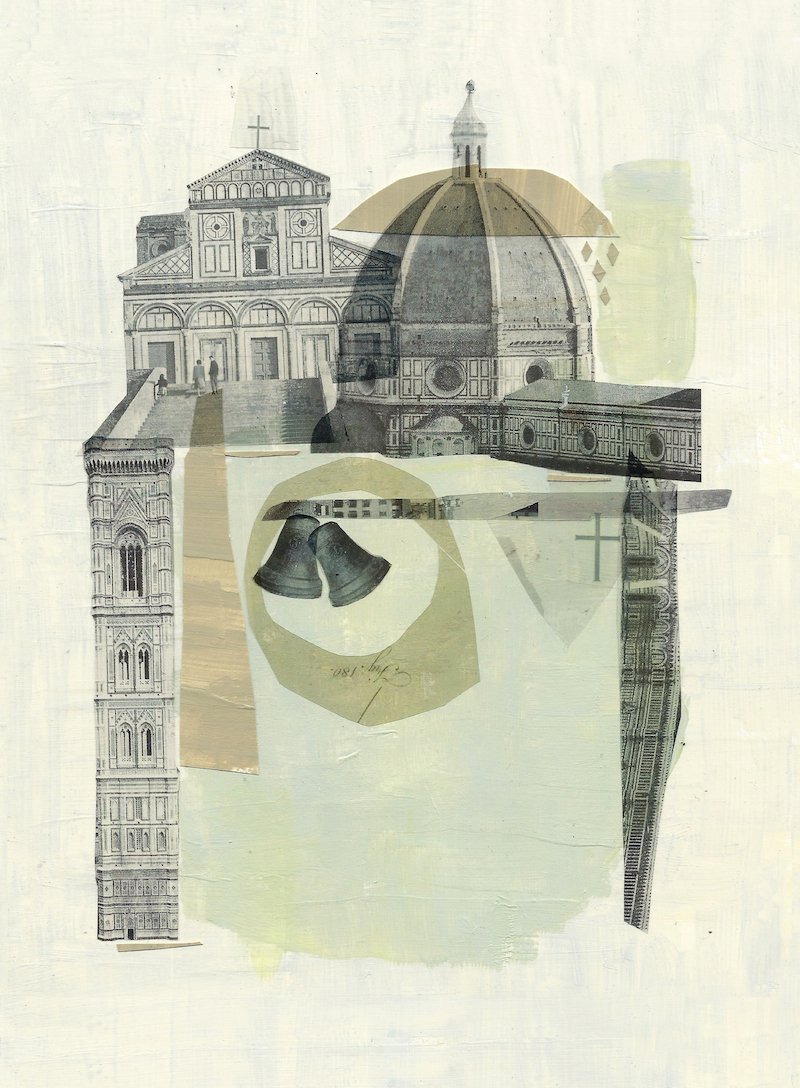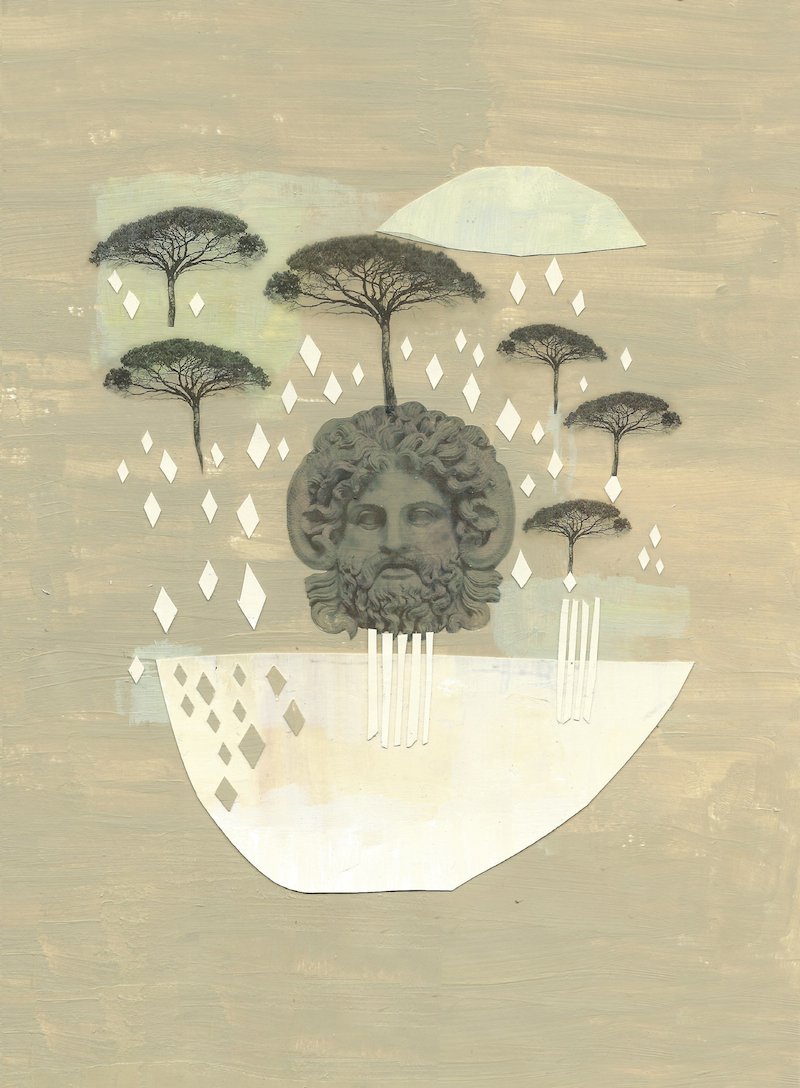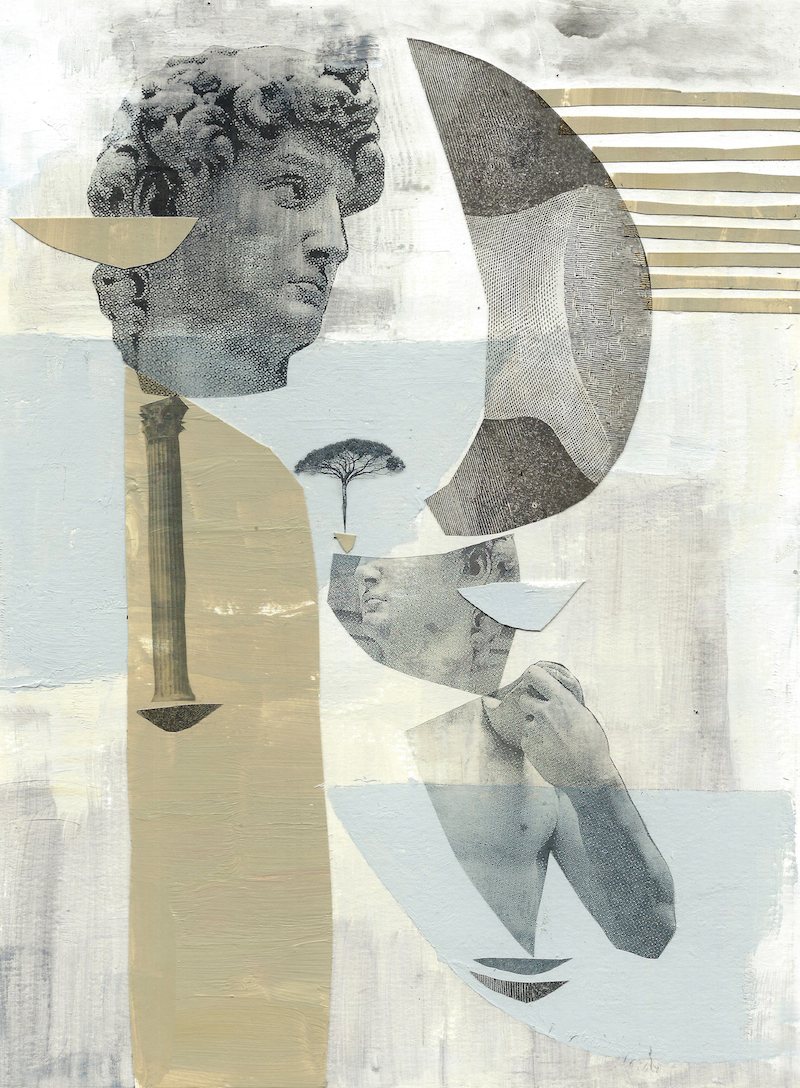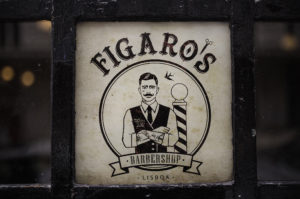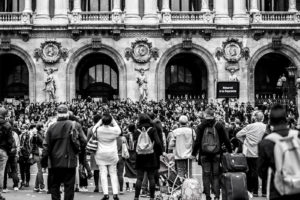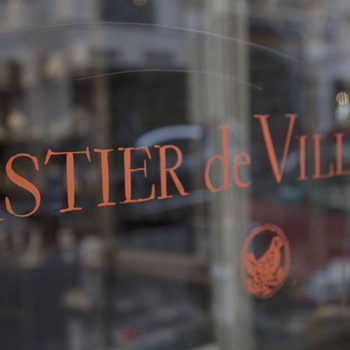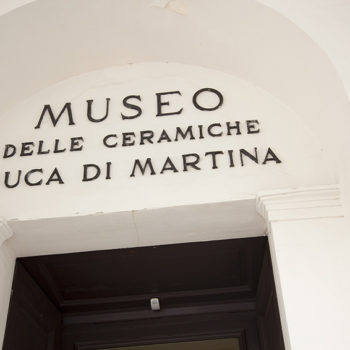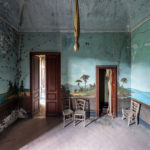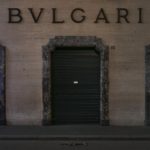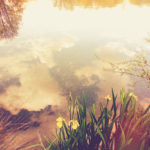by Maureen N. Mclane
illustrator Rosie Roberts
1.4
It is an illusion that we were ever alive
Wallace Stevens, “The Rock.”
It is an illusion that we were ever in Florence.
But we were, for three-plus months this past spring, the bells of the Badia, of Giotto’s campanile, and the bells of god knows what else clanging us awake each morning shortly after dawn.
In the Museum of the Convent of San Marco, a complex rebuilt by the command of Cosimo il Vecchio de’ Medici in the mid-fifteenth century, one finds the cloisters, the refectory frescoed by Ghirlandaio (a Last Supper, the usual choice for the dining halls of religious orders), and most famously the monks’ cells individually frescoed by Fra Angelico. One also finds, in one of the lower rooms, the great bell of the church’s bell tower: called “La Piagnona,” the weeper—after the followers of Savonarola, those piagnone who passionately wept, electrified by his hell-vivifying sermons. When the authorities came to haul Savonarola away, supporters rang the bell to muster aid. To no avail. After Savonarola was hanged and burnt in the Piazza della Signoria, authorities later had the bell itself dragged through the streets and whipped by the public executioner. It lives now on the first floor of the Museum complex, in a room off the small cloister, a massive bronze thing festooned with Medici heraldry, an enormous wooden beam still threaded through its top—the support it no longer needs. When a bellmaster checked it in recent years, he found it had retained its perfect pitches, still capable of sounding reverberantly impressive tones. That bell never woke us.
Our first week: I wake from a dream into a peculiar but not unpleasant sensation—that of bells palpably blooming in my ear, as if they were resonant flowers.
Florence: Firenze: alternative obsolete form: Fiorenza; Latin: Florentia.
Florence: its famously domed Cathedral of Santa Maria del Fiore: City of I Fiori: of Flowers.
Ned Rorem divides the world between “French” and “German”: “The world is divided into two aesthetic styles: French and German. The color red is German. The color blue is French. Men are German, women are French. Japan is French, and China is German. German art is known for being profoundly superficial, and French art, for being superficially profound.”
Florentines are perhaps the Germans of Italy—or so one might think, reading Mary McCarthy (see The Stones of Florence [1959], her still marvelous book). Florentines are (they say) practical, industrious, thrifty yet also witty and mercurial. So maybe Florentines are the Scots of Italy. There is, below or alongside the somber colors, muted tones, the massive bourgeois buildings of the city, a strain of gayety, of measured pleasure, of genial civic festivity. Yet if Italy is a Mediterranean country, Florence does not seem a Mediterranean town.
It is of course grotesque to generalize about peoples, cities, etc. Yet one does.
McCarthy begins her book with a clamorous description of the vast roar and chaos of traffic in Florence: it’s been mitigated some in recent decades by restrictions on driving in the center. Motorinos abound, though, and cyclists, and the few allowed cars and taxis, all salmoning their way along the streams of tourists guided by flag-bearing leaders. The majority of tourists are now Chinese. For how long has this been so?
According to the great chronicler of Florentine art, life, and history, Eve Borsook (see her indispensable Companion Guide to Florence), the Florentines never lost their connection to the Tuscan hillside, to the farms all around them: thus Florence has a rhythm and vibe different from those great urban centers with their own forms of extravagance and urbanity: Rome, Naples, Milan. Mary McCarthy agrees: Florence as a thriving city was always constituted in relation to the countryside. “The typical Florentine villa was simply a farm.”
Only when you go up in the hills—up to Settignano, say, or to Fiesole, or to the small hill on which stands the glorious Romanesque basilica San Miniato del Monte—only then do you realize there are almost no trees in central Florence. It is a town of stone, tile, and pavement. We lived in a palazzo, which was in a sense unremarkable, because you can’t throw a stone in Florence and not hit a palazzo. Our apartment was a small aerie atop a massive structure: its great wonder was the terrace, which looked directly upon the Duomo and afforded views of the Badia (the abbey), the tower of the Palazzo Vecchio, and in other directions the green dome of the Sinagoga and the marble shimmer of the façade of Santa Croce. Florence puts the built into built environment.
Should we have stayed at home and thought of here?—Elizabeth Bishop, “Questions of Travel.”
No.
Florence! I did not dream of you! But now I do.
La letteratura non è altro che un sogno guidato.—Borges, quoted on a plaque in the Feltrinelli bookshop, March 1.
Dante! You should be living at this hour. Your loved and loathed city persists!
Brunelleschi! You made a great dome! And even in the fifteenth century it was a hotspot for gay hookups!
Florence! you are perhaps too staid for the Italophile American poet Fred Seidel. Byron avoided you because you were infested by “the English,” the gossiping cossetted bourgeoisie abroad who rarely deigned to know Italians, other than servants, much less to learn Italian.
Our landlady muses: You know, these people come and they say they love our food, our art, our city, our countryside, but they never bother to learn the language, they never really spend time with Italians.
A rump remnant of Anglo-Florence persists, notably at the British Institute. We joined; as NYU Faculty we could get free memberships.
I attend a lecture there, by Professor John Took of University College London, “Why Read Dante.”
“No one names anyone in hell.”
“No one in hell says I grieve. I sorrow. They simply persist.”
We try to learn (in my case) or improve (in L’s) our Italian. We take a two-week intensive course at the Scuola Toscana, near Santa Croce—an amiably chaotic yet ultimately effective school, it seems. Many students are Swiss and German; there are a few Japanese, a rare Spaniard or American. Grammar in the morning, conversation in the afternoon. I slowly become capable of describing my meals, my walks around town (faccio un giro a . . .), a visit to the market or to the museum: all in simple present tense. I download e-books of basic Italian grammar and phrases. The books are obsessed with relationships, eating, drinking and socializing—but especially with relationships: do you have a girlfriend, do you have a boyfriend, how many children, do you want to meet tonight, this is my uncle, how is your grandmother, would you like to get a drink, etc. The vision of life is thinly erotic, normative, amusing, largely unhelpful in language acquisition.
The unruly horrors of Italian articles, prepositions, the “bitty words” as my friend Catherine observed—gli, lo (as in lo sport, lo sbaglio), di, da, de, etc.
My bookish, half-remembered Spanish interferes with elementary Italian, as does my terrible tourist’s French. Slowly some basic templates get laid down, yet by now those memorized paradigms and those few ready phrases (Ho bisogno di praticare il mio italiano; A che ora chiude il negozio?; Posso prendere un caffé?) are fading into so much aria.
Class is cancelled for Easter Monday, La Pasquetta. We decide to emulate the Italians and make a foray to the countryside, or at least to a local park: Cascine Park—where Shelley drew inspiration for his “Ode to the West Wind.” The birches are beginning to leaf out; the Arno widens here; cyclists of all generations drift and wobble by. No racers in sleek athletic gear here. An amusement park anchors the eastern end of the Park—cheesy pop blaring from the Tilt-a-Whirl, the merry-go-round, from the booths where you can shoot for prizes. Some aspects of amusement seem international.
I take a make-up language class with a more advanced group of students: they are learning vocabulary related to holiday traditions—Natale (Christmas), L’Epifania (Feast of the Epiphany). Our teacher, an energetic, genial woman named Laura, lays out the various customs surrounding these. We fill in the blanks of sentences about midnight feasts, fireworks, and the old witch, La Befana, who brings children gifts on Epiphany. One Japanese student, clearly gifted in languages and thoughtful, raises her hand with questions about Natale. She asks for clarification: is not Zeus the father of Jesus? non é Zeus il padre de Gesù?
The Svizzere who dominate the class are amazed and delighted, as am I: with the Japanese woman’s question, “The West” collapses into a heap of crazed reproductive and genealogical mythologies. It’s especially nice that “Zeus” and “Jesus” virtually rhyme in Italian. Yes these gods chime. Our teacher pauses and launches, in Italian, into an extended account of the annunciation, the miraculous conception, and the birth of Jesus (the shepherds and then I Tre Re make their appearance too): a set of plot points that, thrown into relief this way, seems far crazier than Zeus’s morphing into a golden rain to impregnate Danaë.
It’s also clear that our teacher is a benevolent Catholic, a nondoctrinaire one.
An Anthology (from the Greek: a “gathering of flowers”):
—the tulips I buy for L’s birthday. I ask for the “blanco” ones: the florist pauses and sternly yet gently corrects: “i bianchi.”
—crocuses and unnameable wildflowers in the Boboli Gardens in late March.
—the bouquets of mimosa our landlady brought for each of us on Festa delle Donne—International Women’s Day, very much observed in Florence. Half-priced aperitivi for le donne!
—the blizzard of blue irises in the limonaia at the Villa La Pietra, mid-May.
—wisteria: first the pinkish variety then the white adorning the walls, perfuming the air along the Arno and up at Villa La Pietra.
—the azaleas and finally the roses in full bloom at the Orto Giardino on the way to San Miniato.
—the astonishingly variegated irises of the Iris Garden, during the brief charmed days of public access to the Garden, off the Piazzale Michelangelo.
—red horse-chestnuts in the Giardino dei Semplici.
—the poisonous plants of the Medici.
—the stiff lily the angel bears toward Mary in Botticelli’s Annunciation.
—the delicate and sad still life—lilies, irises, columbine, some wilting, petals fallen on the ground, each flower a theological allegory—at the lower center of Hugo van der Goes’s great Portinari Altarpiece, with its rough-hewn hyper-realist shepherds, somber Mary, severe attending saints, small angels with identical faces but distinctly different wings, gesticulating townspeople in the background. (See Judith Testa,An Art Lover’s Guide to Florence [2012], for this painting and for in-depth considerations of some major works. The encyclopedic Borsook reigns, but Testa is a spiky supplement.)
I venture into one of the more luxe shops, Tornabuoni, on the Piazza del Duomo. I won’t buy but I will look. An amiable clerk there shows me some of their purses, satchels, briefcases. In the early 2000s, he tells me, an enterprising Chinese person realized that “Tornabuoni” was still a free domain name—and he registered it. Thus any product labeled “Tornabuoni” is assuredly not a Tornabuoni product. The “real” Tornabuoni line is now called Primopiano.
The clerk continued: The Chinese are admittedly excellent—their stitchwork, their feel for the materials, but they have no fantasy. They just copy.
“Talented copyists”: how the official leaflet describes the unknown Roman artists who frescoed the pleasant bourgeois homes of doomed Herculaneum, horrifically flash-preserved like Pompeii by Vesuvius.
In Fiesole, the Roman ruins. Amidst the ruins of what had once been the cistern by the pool: a hedgehog nosing. From the small group of touring Italians: Un riccio!
What you thought
by the Arno
a beaver
was a river rat—nutria—
& here in the ruins
of a Roman cistern
what you thought
a hedgehog was
Late April.
stippled hills the olives
stapled to the earth
another cypress strangled
or is it embraced
by wisteria
La nuvola fa la pioggia.
Le nuvole fanno la pioggia.—?
American students overheard:
“Show me your curses.”
“You have to see the gardens today. They are ridiculous.”
“More cushion for the pushin’.”—A young woman pats her ass as she settles herself on the grass among friends.
The clouds prove the campanile
a still unbending tower
They flow through this sky
faster than the hour allows
and the tower moves
into another century of clouds
The green white and pink marbles
declare the republic
a festive thing. Fireworks
for all! And hitch your horses
to the palace rings.
There is a nun or former nun who still dresses as a nun and apparently conducts herself as one who is the librarian and custodian of the English (actually Swiss) Cemetery in Florence. Julia Bolton Holloway. She is erudite, passionate, capable, elderly, shrewd, vital; she runs a Sunday alphabet school for Roma children and their mothers; she runs it out of the small library she’s established at the cemetery.
She quotes a proverbial gloss on Florence: “a sunny place for shady people.”
A medievalist and an expert on nineteenth-century literature, on the Brownings in particular, she takes a dim view of Robert Browning. Elizabeth is buried here in the cemetery. So is Walter Savage Landor and several figures crucial in the abolitionist movement: Theodore Parker, to whom Frederick Douglas paid tribute.
Of Fanny Trollope (also buried here): “her novels are better than her son’s.”
She is contemptuous of the Medici and aghast at the success of their propaganda over the centuries: ambitious, wary of the republic yet savvy, the first generations of important Medici—from Cosimo il Vecchio through Lorenzo il Magnifico—managed to ally themselves with the republic even as they banished, killed or neutralized all enemies (which, of course, their enemies had done or were prepared to do as well to them). They had, inarguably, good aesthetic judgment, patronizing (among others) Donatello, Botticelli, Michelangelo; both Cosimo and Lorenzo were great patrons of scholars as well, of the new humanists, and were civic benefactors. Their successors—half-confected Medici, bastards and Popes and propped-up wastrels—swelled into grotesque parodies of magnificence, their taste degraded, their once careful obeisance to the forms and norms of the republic utterly shattered, as the ducal Medici established a virtual police state manned by Spanish and other foreign guards.
Magnificence: a virtue, a virtú, the Renaissance humanists knew. Magnificence is a signal virtue of Renaissance Italy. Magnificence: from magnum facere: to do something great.
A group sits and talks: of social habits, of the premature familiarity Americans indulge in, the regime of pseudo-intimacy—everyone addressing you by your first name right away, never asking how you might wish to be called, the promiscuous meaningless “friending,” etc. An Italian friend notes: in Florence, we would say, we haven’t yet shared soup together. In Rome: We haven’t broken bread together.
Mid-May
The spiders have finally come in
For weeks they amassed
on the terrace their tiny red bodies
scuttling along the terra cotta.
Are they the populace
mercenaries for some hidden spider prince
or a bold self-declared republic
We are not sure
if they bite or are poisonous
Crushed they make the dark red smear
of certain frescoes we saw
at Herculaneum.
Some love volcanoes
Some romance the threat
Others ignore what’s almost too small to see
Notes on Hands: that Fra Angelico carefully painted the veins of San Domenico’s hands, as he grips the cross of the crucified Christ on the wall of the small cloister of San Marco.
“The Madonna and Child with Saint Anne,” by Masaccio and Masolino, in the Uffizi: “Renaissance” and “Gothic” elements contend, combine, in the early fifteenth century. Art historians say Masaccio painted the solidly impressive Mary and Jesus, Masolino the more decorative angels and Anne. Look at those angels’ limp hands, L. says. Masaccio would never have painted those hands.
The hands of Michelangelo’s David are so large because the sculpture was commissioned to be stationed along the roofline of the Cathedral: from the ground, then, the perspective would be appropriately adjusted—a strong visual focus on the giant-slaying hands that so brilliantly launched their small weapon. When the sculpture was finished, it was so immediately and energetically acclaimed that the civic worthies decided it should be stationed in front of the Palazzo della Signoria, as a civic symbol: and there it—or rather a copy—still stands. The David Itself (i.e. Michelangelo’s original) now housed in the Accademia, for which people wait in line long hours to see.
•
We did not climb up the Duomo
did not visit the cupola nor the lantern atop it
& David elsewhere stood, turned, his massive hands
unscanned by us who never ventured
where they’d moved him but often looked
at his copy in the common square.
We didn’t see what they said
you should. The night sky was bright
as the unelectrified countryside
of Canada and there one saw
beside the dome & the belltower
two stars we’ve been taught
to call planets, Jupiter, Venus, ruling
our days whether or not we knew
their names or ever thought
to look up
•
One looks and looks and looks again. The pleasures of returning—to that painting, that cloister, that café; the pleasures of a long slow half- or unconscious absorption. But is it absorbed? does it all drift away, a merely accumulative series ultimately meaningless, “Everything only connected by and and and” (Elizabeth Bishop, “Over 2000 Illustrations and a Complete Concordance”)?
•
From Edward Hirsch’s interview with James Salter (who has just died), The Paris Review 127, 1993:
Interviewer:
What do you think is the ultimate impulse to write?
Salter:
To write? Because all this is going to vanish.
•
How a city can bake in a valley.
“In summer, Florence is worse than Rome, than Sicily!”
“They say it is cooler in the hills. They say that but it is not so.”
“I am so glad you were able to see the spring—it is glorious. In July and August everything goes brown and dusty and dead.”
When we arrived, in February, virtually every woman wore a three-quarter length down coat—a fairly sleek one. That was the uniform. These coats persisted well into early May. One felt gauche and naked wearing a mere t-shirt.
Visitors were surprised people did not dress more formally on the streets. Yet there was still a marked look, a style, especially among the men, who were so much more interesting to look at than your default American man shuffling through a generic city. First: the shoes. They were hardly ever sneakers. Nor were they some safe anonymous black solid boot or shoe. These men wore beautiful shoes of various leathers and toolings and styles and colors—rusts, deep greens, fawn browns, as if the men were elegantly hoofed to step out. Also: scarves. The young students would wear scrappy cotton scarves loosely draped around their necks, over their t-shirts and under their jean jackets—a look I might have thought cheesy but which instead had a kind of relaxed dash about it. The older men, more formal, sported woolen or silk scarves wittily knotted or flung. Somewhere between the drab and the peacock, this attentive pleasing care—both the men and the women showed it.
•
We were having aperitivi at our local, an unpretentious, excellent pastry shop/café, La Loggia degli Albizi—and a crowd of students had taken over the small outside patio, one of them sporting a laurel wreath: a recent graduate. As the students genially drank and chatted and smoked, the genial hubbub was punctuated every ten or so minutes with a rousing chorus, usually led by one of the semi-drunken young men:
Dottore, Dottore,
Dottore del buco del cul!
Vaffancul Vaffancul![Doctor, Doctor
Doctor of the mouth of the anus
Go fuck yourself Go fuck yourself!]Hail to the graduate!
•
When we told a Roman friend that we’d be spending the spring in Florence, her eyes widened: “BORING!” she declared.
And from a certain angle, she was not wrong
Though we didn’t really test that—didn’t really test the nightlife, clubs, scenes of writers, artists, musicians, activists, teachers. We are hardly good informants for “what the city is really like.” We were perched there, looking and musing, not integrated into the life of the city in any deep way.
•
“What friends did you make?”
I didn’t make friends. A failing, or?
I take it back. We met a dynamic Turkish historian, poet, and editor: Levent Yilmaz. He had a fellowship at I Tatti, Bernard Berenson’s former villa, now an outpost of Harvard, for visiting scholars. We had lunch there, amidst the carpets, books, Trecento paintings, and gardens. And I twice visited Julia Holloway, at the English (sic) Cemetery. L., more gracious and with functioning Italian, made some other friends too.
•
We keep an eye on the euro; we follow the fortunes of Greece as it’s squeezed; we hear of Roma camps cleared; we scan the anti-gentrification graffiti in the Oltrarno; we read of the privatization of one of the few parks left in the city; we see the plaque by the rail station where the Shelleys lived; we visit places important to Eugenio Montale, as Jonathan Galassi advised; we ride the efficient buses; we read La Repubblica; we go to the anarchist festival; we go to the Scoppio del Carro (“Explosion of the Cart”), the Easter fireworks display at the front of the Duomo; we then attend Easter mass; we feel a mild earthquake; we go to the opera, a well-sung but peculiarly staged Dido and Aeneas; we go to the Synagogue; we go to Siena and then begin the great Italianist Jane Tylus’s astonishing new book on Siena; we see anonymous pithy poems posted on walls throughout Florence, the work of the Movimento Emancipazione Poesia (MEP), founded in Florence in 2010; I go to Arezzo; we go to Naples, to Sicily; we eat ribollita, pasta with fresh peas, baccala alla Livorneses, pici in Siena, have a taste of the famed bistecca fiorentina; our pescaterianism gives way to some flexitarianism, though we draw the line at tripe and lampredotto—however molto caratteristico.
We read the open letter of the Mayor of Lampedusa, Giuseppina Nicolini, who in 2012 denounced “Europe’s silence” over the fate of refugees and immigrants dying as they struggle to reach Lampedusa, Sicily and other Italian shores. “Everyone has to realise that it is Lampedusa, and its inhabitants, with the structures providing rescue and reception, which give human dignity to these people, and who also give dignity to our country and Europe as a whole. So, if these deaths remain solely Lampedusa’s responsibility, I would like to receive a telegram of condolence for every drowned body we receive—as if it had white skin, as if it were one of our own children who had drowned whilst on holiday.”
We read and watch from afar as black Americans are killed on the streets and in custody.
Freddie Grey; Tamir Rice; Walter Scott.
“Custody”— late Middle English: from Latin custodia, from custos“guardian.”
“Custody”— “the protective care or guardianship of someone or something.”
“Custody” —“imprisonment.”Between these definitions people die.
#BlackLivesMatter.
What was the dream of America? Amerigo Vespucci was a Florentine. An accident of naming.
What was the dream of the European Union? Of Europe?
•
Time To Eat
The thing is I get tired.
And then maybe I’m wired.
I want to bite il tuo capezzolo
not hard enough so you’d know.
Non lo so. This is what I say
to myself when I don’t know
how it goes. The lavender blooming
the redbuds too and you wouldn’t have wanted
to have missed the wisteria.
Everything’s missing
us. Turns out
it’s a transitive world.
The EU flag’s unfurled
& perhaps soon to be furled.I am going to breathe the wisteria’d air.
I proclaim luxe calme et volupté everywhere.
Houellebecq never got it wrong—the way
some dudes can fuck all they want
& others hangdog mope about
& can’t get laid. Rev up
your rage machine. Redistribution
for all via Allah. O right
just for the guys.
No one names anyone in hell.Seidel’s poems are all vroom vroom.
Mine are more like can I get a room
not at a palazzo though it’s true we’re in one
Not in some crumbling albeit refined torre
of some decayed branch of the Albizi
It’s impossible not to rhyme
at least in Italian with its endecasyllabic chime
Impossible not to be on time
if you’re a fascist train or to be late
if you’re not. And if the mosquitos
have begun their whine
far better for you that you never do.
To whine’s the opposite of sublime
and that’s what we are, or you are
Federico il Magnifico! Colossus
of rhyme, elegant pugilist
of a shrunken time.The Ducatis of Bologna
the vaginas of Rome
what’s not to like
when you ride it
like this?
What’s not to kiss
if you’re feeling sentimental.
Why not say what happened
to Robert Lowell? Why not hang
out with the artist who spends her days
pole-dancing? They are all so fit
and tight those dancers.
The discordia discors
of my mind is so fitting.
All this talk about genitals
makes me mental.Granted: I am an inmate of a mental hospital.
Admitted: Gunter Grass rejected the Final Solution
though he was SS.
Where are the snows of yesteryear
and the icebergs
which brought us disaster
movies and rivers aflow
and a bevy of polar bears?
Here it’s all Sturm und Drang.
Quanto costa
la borsa. Quanto
costa la giacca. Quanto
costano le scarpe.
Quanto costa la vita.La sua vita, la mia.

